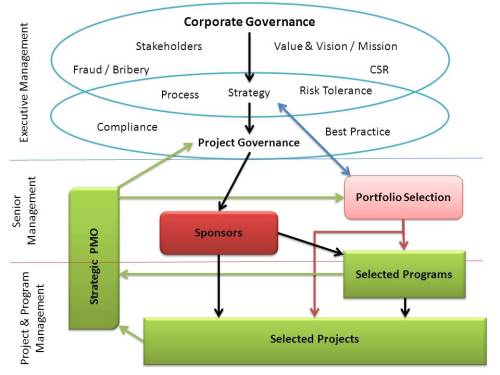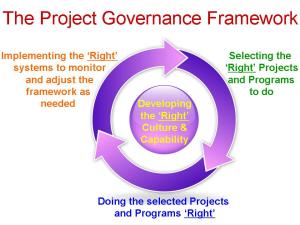Corporate governance is defined as aligning as nearly as possible the interests of individuals, the organisation and society. Good governance is good business!
Project governance is a sub-set of corporate governance, focused on systems that ensure the right projects and programs are selected by the organisation, and the selected ‘few’ are accomplished as efficiently as possible. Projects that no longer contribute value to an organisation should be terminated in a way that conserves the maximum value and the resources reallocated through the portfolio management process to more valuable endeavours.

The framework for effective project governance is laid out above, and is an executive management responsibility. Sponsors and the Portfolio Selection/Management processes provide the key link between the executive and the working project and programs (for more see our Governance White Paper).
The focus of this post is to look at the pre-selection activities that inform the portfolio selection processes. One of the key conclusions to be drawn from the Ombudsman’s Report discussed in my earlier post Cobb’s Paradox is alive and well was that many of the projects that contributed to the $1 billion in failures were set up to fail – the projects had absolutely no chance of delivering within the announced parameters: the inputs to the portfolio selection process were grossly flawed (or were non-existent).
This appears to be a wide spread issue. Most project management standards such as ISO21500 and the PMBOK® Guide start with an approved project and a business case or similar that defines what has to be accomplished; this is the end of the portfolio selection process outlined above and is assumed to set realistic and achievable objectives.
What is missing, are the steps leading up to this point; the life of a ‘project’ starts with an idea, need, opportunity, requirement or threat (the ‘concept’). The organisation assesses and studies the ‘concept’ hypothesises options and solutions and frames a proposal that becomes the foundation of a future project. These key investigative elements of a project generally sit under the portfolio umbrella developing information to allow a proper decision to be made. In mining this can represent exploration, feasibility studies, ‘bankability’ studies and concept designs which between them can cost $millions, leading to project funding. Importantly, this ‘Front End Loading’ (FEL) is seen as the key to a successful mine in most major mining corporations.
Similar problems exist in major infrastructure projects, defining a solution to prison overcrowding can involve building a new major prison, building several smaller prisons, extending current prisons, changing the way criminal justice system works to reduce the need for prison places, or a combination of the foregoing options (substitute University/hospital/school, into the previous sentence to see just one dimension of the challenge). However, unlike mining, most government and many corporate organisations see effective ‘front end loading’ as unnecessary.
Other organisations use the process to formulate definitive solutions to problems they have no real understanding of (typical in ICT) and then pretend the defined solution has no associated risk (because it is defined) despite the fact the full dimensions of the problem the project is supposed to solve are still unknown, and are frequently changing over time.
The challenge, requiring informed judgement and effective governance is recognising which development processes suits what type of ‘concept’:
- Sometimes, the ‘investigation’ requires a significant amount of work (eg, a bankability or feasibility study); this work may be treated as a project in its own right, and is time, cost and resource constrained with a defined deliverable (the report).
- If the work is expected to flow forward and will only be stopped in exceptional circumstances, project phases work best, with some form of ‘gateway’ or transition review.
- In other circumstances, studies are undertaken as part of the portfolio by corporate or PMO professionals with no dedicated budgets, assessing multiple proposals as an ongoing process, but once a concept gets the go ahead a project is created and a budget and resources allocated.
- Other concepts (particularly problems) cannot be defined and an ‘agile’ approach is needed where elements of a partial solution are developed and put into use developing new learning that will then allow the next module to be developed in a progressive sequence. However, whilst this may be the most suitable and cost effective way of developing an effective solution, budgeting in a traditional ‘iron triangle’ concept of fixed cost, time and scope is impossible.
The challenge is recognising which type of project is being proposed (based on Project Typology), and then deciding which type of process will develop the best input to the portfolio selection process and what level of uncertainty (risk) is associated with the proposal once developed. Certainty is not important, what matters is appreciating the extent of the risks and the likely benefits, so an informed investment decision can be made. Most ‘game changing’ initiatives involve high risk, high reward projects that create a totally new future!
OGC Gateway™
The OGC ‘Gateway Reviews’ is a flexible process that addresses this part of major projects from the client’s perspective:
Gateway 1 = Business Justification, options identified and appraised, affordability, achievability and value for money established.
Gateway 2 = Procurement strategy, will the proposed strategy achieve the project objectives?
Gateway 3 = Investment decision, based on realistic project cost information (eg, tenders or bids) can the business case be confirmed from both the cost and the benefit perspective?
Gateway 4 = Readiness for service. The completion of the project work and a reassessment/confirmation of the expected benefits as the deliverable is put into ‘service’.
Gateway 5 = Benefits evaluation. Did we get what was expected now the project’s outputs are being used?
Summary
Most of the risks and rewards associated with a project or program are determined long before the project manager is appointed; if these decisions are wrong (or non-existent) project and program management cannot resolve the problem.
The role of effective project management is to deliver a realistic and achievable outcome efficiently; if the parameters for the project are unrealistic in the first place, the best project management can do is stop the situation deteriorating further! As far as I know, none of the various BoKs and methodologies, including the PMBOK® Guide has a ‘miracle’ process that will magically transform an impossible set of objectives into achievable set of objectives. Wishful thinking is not an effective substitute for effective project governance!






